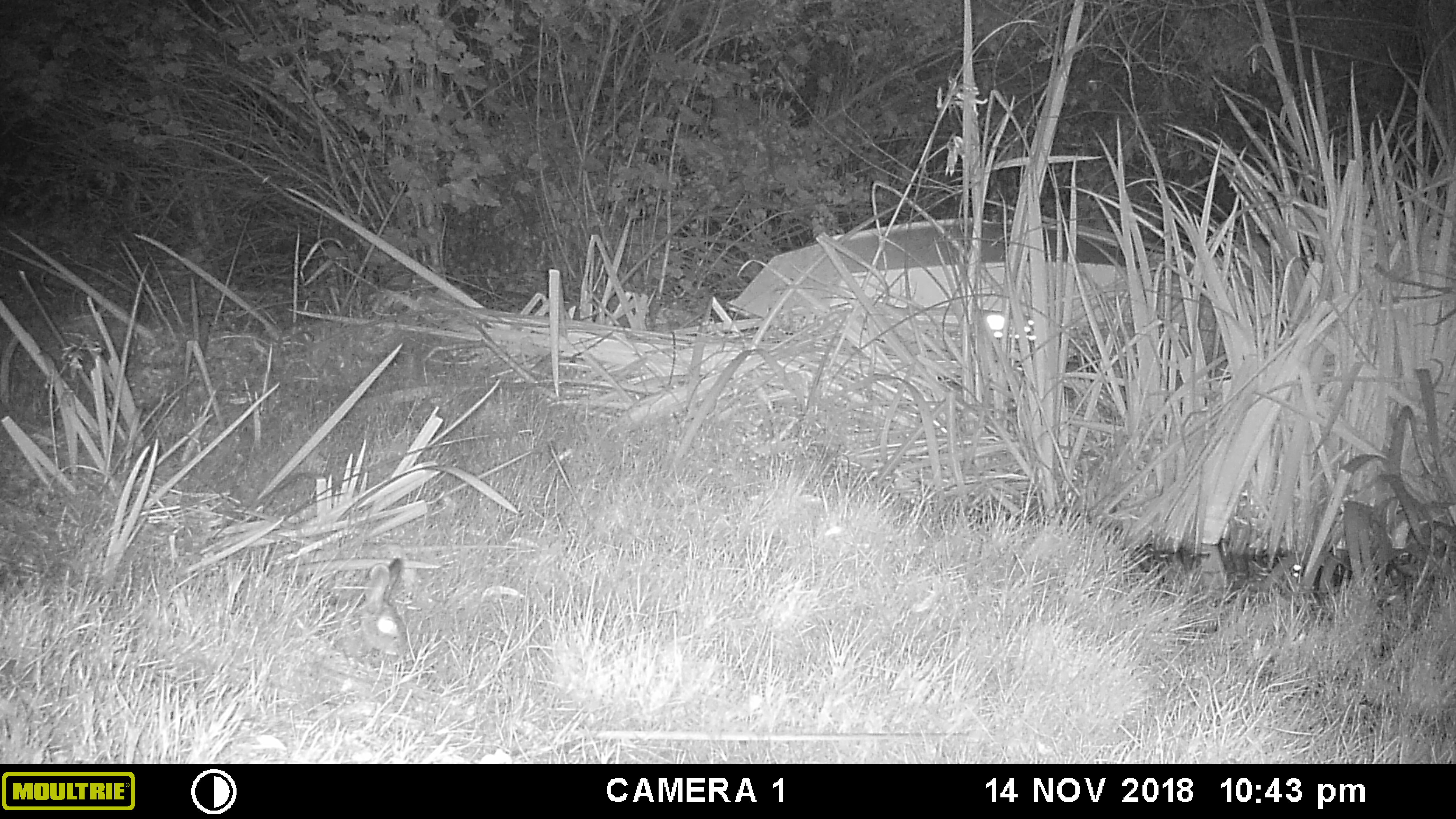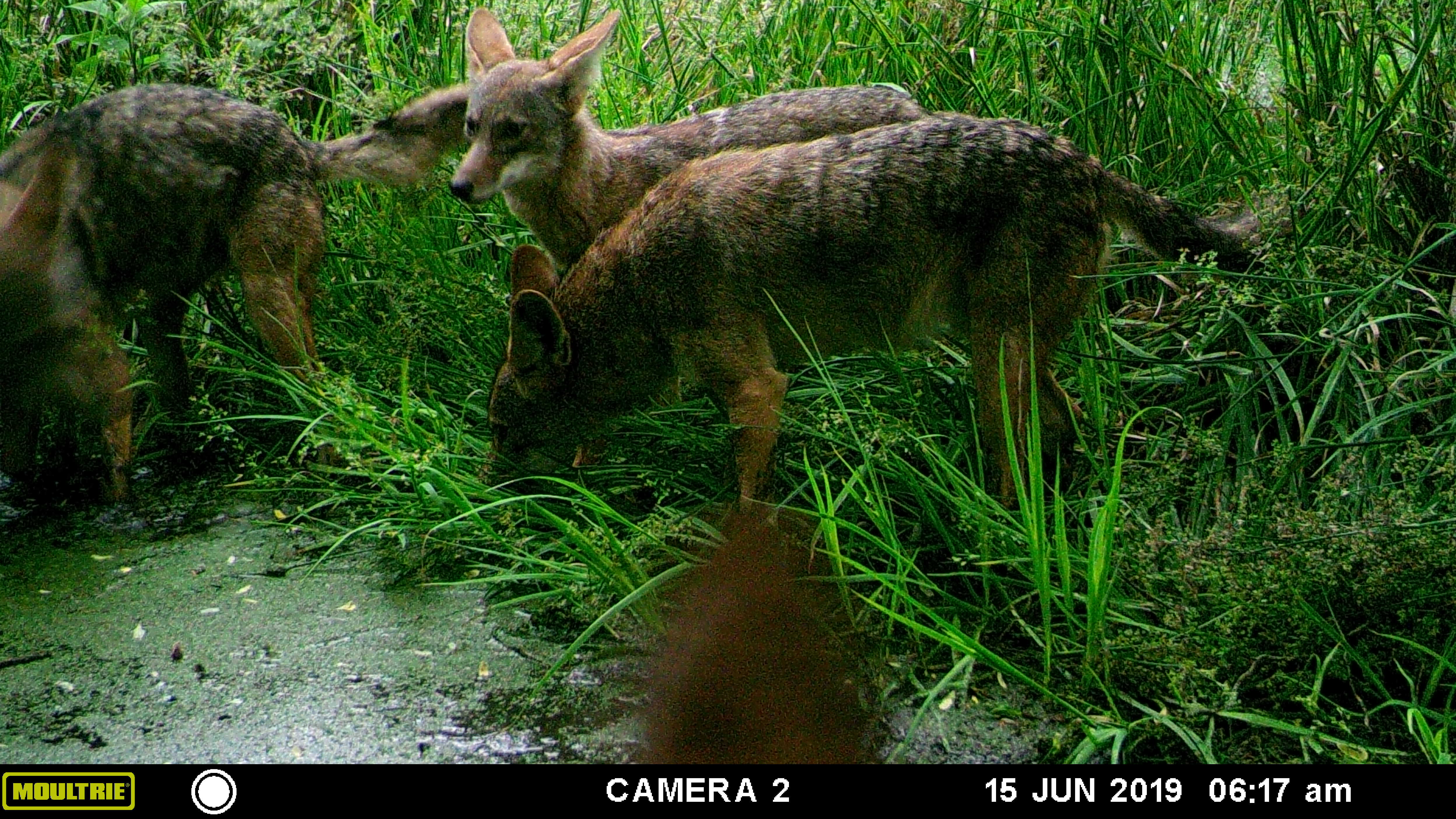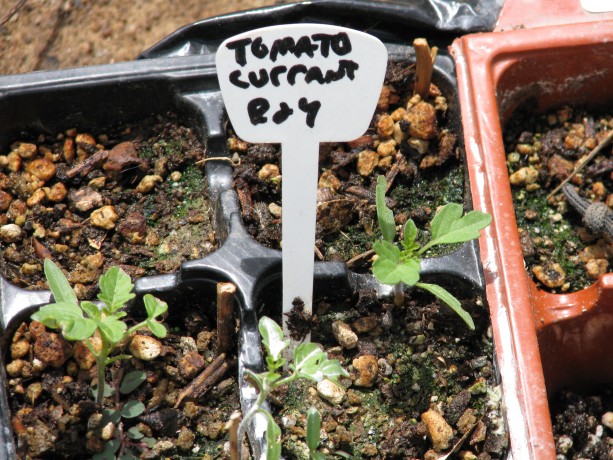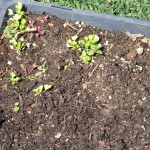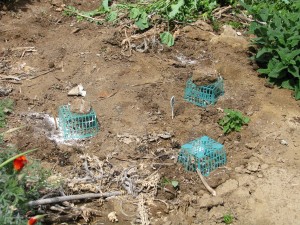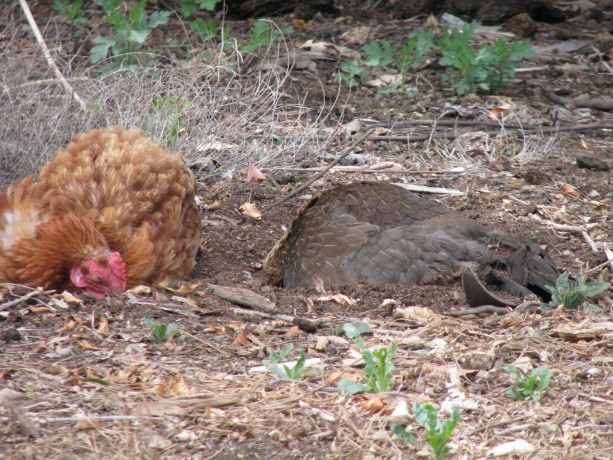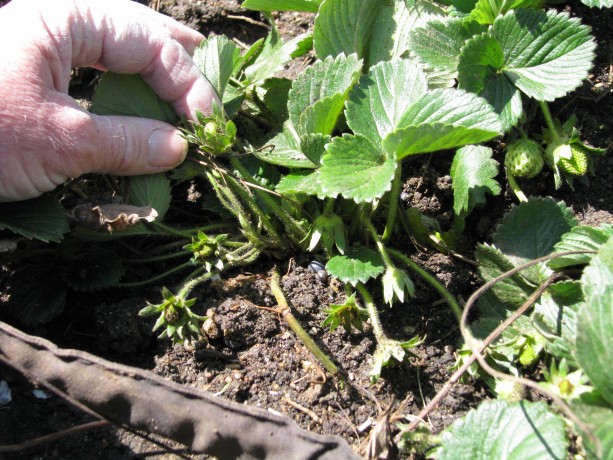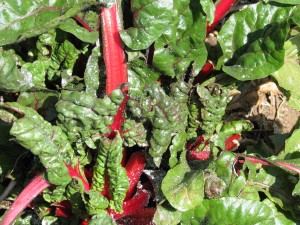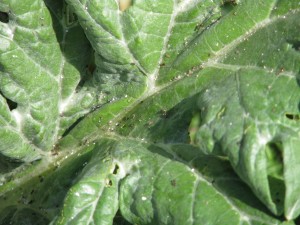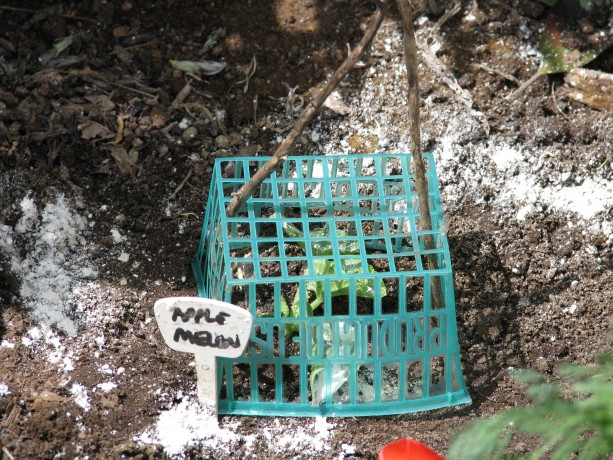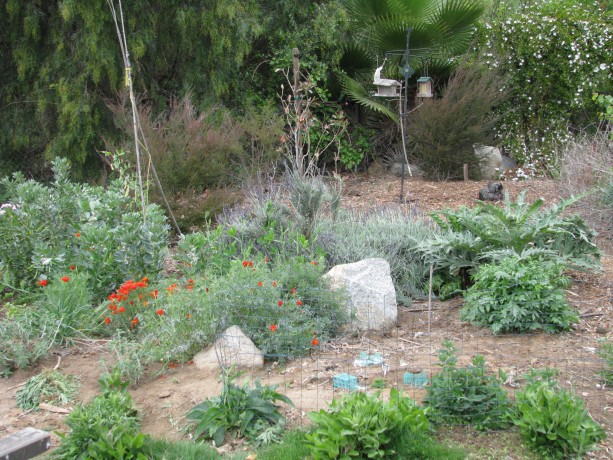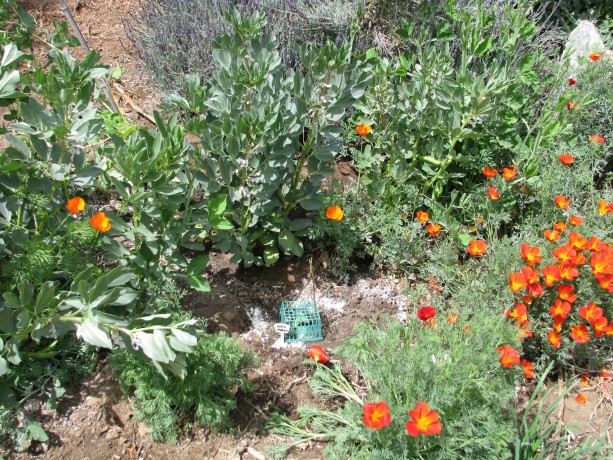-
Release of the Pullets, and No More House Chicken
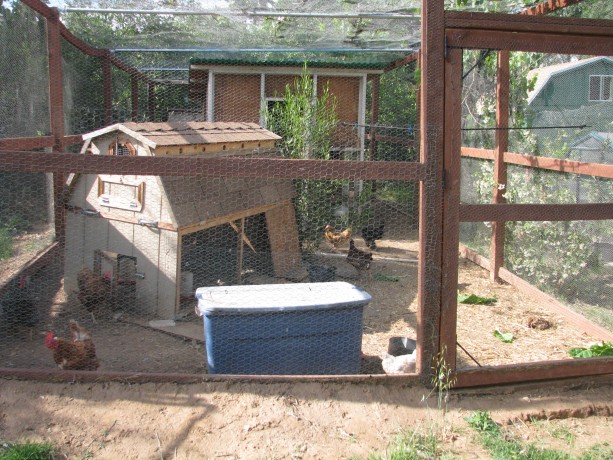
The Fowl Fortress and its many inhabitants. It was time. The little chicks were half-grown and beginning to eat scratch and pelleted chicken food along with their chick starter. They had finally figured out how to go upstairs at nighttime although it took several tries where I had to pick them out of their chick pile and shove them through the upstairs egg window. A couple of times when I’d let the big girls out into the garden, I had let the little girls out into the Fowl Fortress. They had run around stretching their wings and barreling into one another. So it was time for them to join the big girls as one large flock.
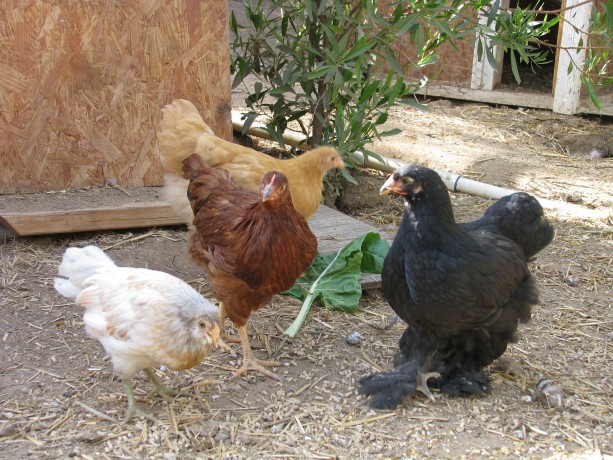
Four of the seven little girls. L-R: Belle, Charlotte, Esther (or Myrtle. They look and act the same), and Mulan (please don’t be a rooster!). And then there was Viola, the house chicken. She’d been a house chicken for over half a year, enjoying her special front yard paradise, coming when called, stealing some dog and cat food, caging herself at night, and crooning away whenever I sneezed or made noise while she slept. I really loved to have my house chicken. However she was alone a lot. She protested her aloneness by shrieking horribly for long periods of time. She could shriek with both exhaled and inhaled breath so that the noise didn’t stop. Even when at the end of my rope I yelled at her to shut up, she shrieked. She was becoming a spoiled and lonesome chicken. Her leg, the reason for her separation from the flock, was doing well again. I thought that if there was ever a good time to reintroduce her it would be at the same time that I let loose the little girls. There would be less hostility against Viola when the hens reinforced their pecking order. It was a very hard decision to make, but I thought it was for the best. I left the cage up in the house, though, just in case.
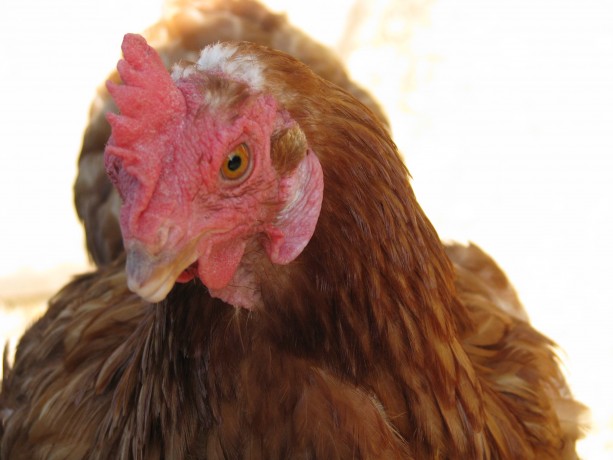
Madge: not just a rescue anymore! Uber hen! Last week I gave Viola a surprise and brought her down to the coop when I let the hens out of their chicken tractor. Viola wasn’t happy about it. Immediately Madge, the one-eyed Rhode Island Red who had been caged with Viola at the feed store when both had been seriously pecked, who had been her only friend for a year with my other girls, decided to punish Viola for her absence and make sure she knew she was at the bottom of the pecking order. She didn’t just give Viola – who is smaller – a peck, she tried to remove feathers. She jumped her and chased her. I had to get between the two of them. Pushing the vicious Blind Pirate Madge away just made her more intense, so I tried picking her up and giving her attention.
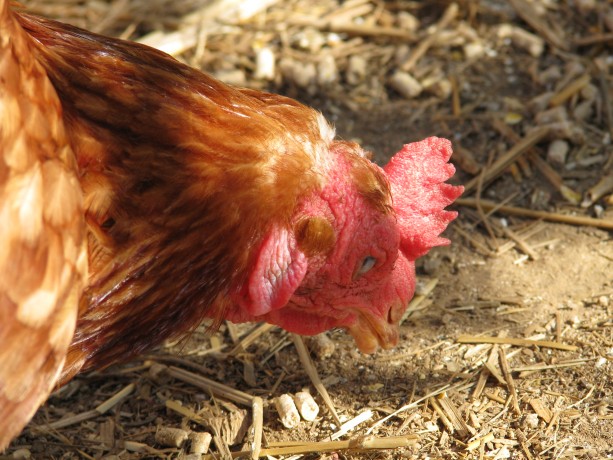
Paritally blind Madge… who’d have thought that she’d give the others the fish-eye? That worked better. Still, Viola had to hide. With Viola between my legs for protection I released the little girls.
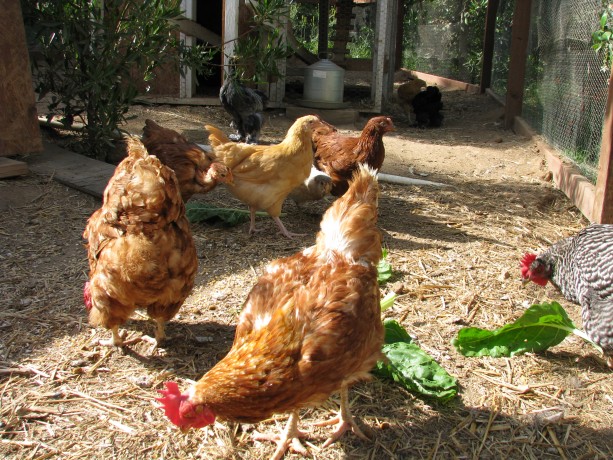
Viola staying close. L-R: Madge’s butt, Malaika, Esther (or Myrtle), behind is Bodacea, crouching is Belle, Charlotte, in the back is Myrtle (or Esther), Mulan, and on the right is Lark. Not pictured: Chickpea and Miss Amelia, the flock leader. The big hens… pretty much ignored them. The little girls were so happy to be free. I kept their food inside their coop and propped the door so that only the smaller birds could get in there, but the big girls managed to shoulder themselves in anyway.
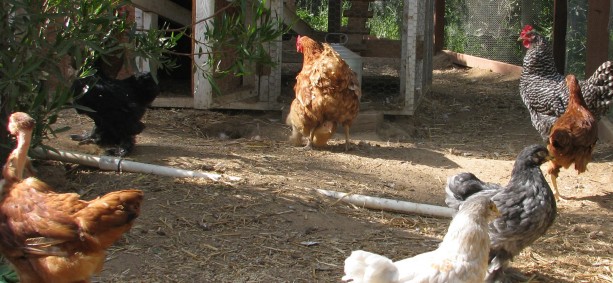
Madge shows her ranking to Myrtle as others look on in alarm. Lark, the Barred Rock who has been barren since she survived egg binding and who has been enjoying her work-free status has developed some kind of uncomfortable swelling. At first I thought she was just fat, but her tummy swelled like a balloon over several weeks. She lost her feathers on her red rump.
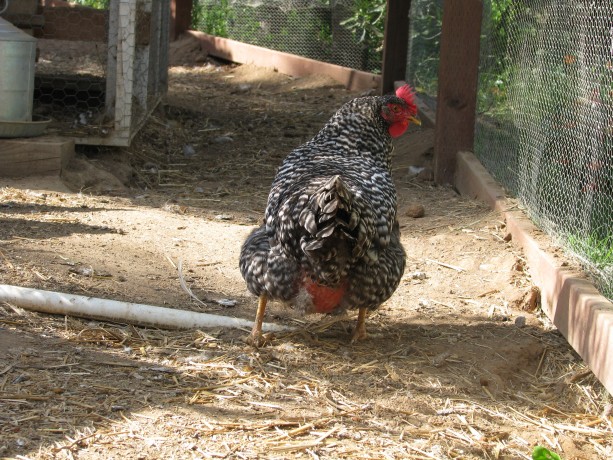
Lark’s uncomfortable ailment. It became awkward for her to walk so I gave her a couple of Epsom salt baths in the kitchen sink, and she became a house guest for a couple of days. She wasn’t as pleasant as Viola, but enjoyed the new experience. I returned her to the coop, and just today the swelling seems much less, thank goodness. The whole illness has not, however, affected her appetite.
Belle, the crossbill Americauna, had such difficulty eating that she is smaller than the rest and seemed to always be famished.
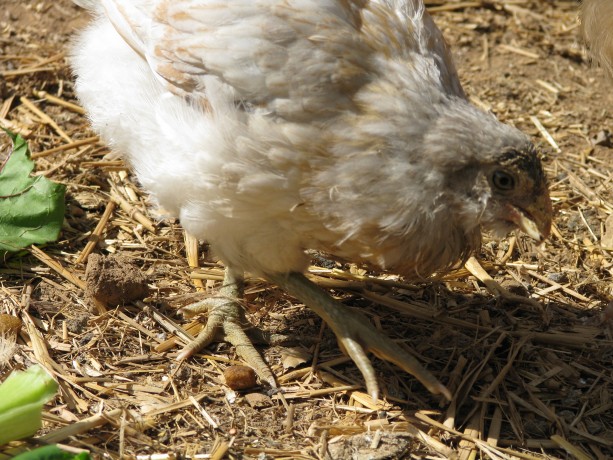
Belle, the Americauna who has the cross-bill trait. Small but sassy, and usually covered with mash. I finally found a small, deep tupperware container that I could wedge between a piece of wood and the side of her coop where it wouldn’t tip over easily, and filled it with chick starter and water mash. Belle was eating heartily for the first time since her bill began to cross and for once she had time to spend goofing around with a full tummy. And a messy face and breast. Since I’d tried trimming her beak, and since I make the magic mash for her now, she has become not only an energetic chicken but a devotee of me. While the other ingrates run away as if I were an axe murderer rather than the vegetarian that I am, Belle flies onto me at any chance. With Viola between my ankles and Belle running up my back I feel very much a part of the flock.

Ah haz a friend! -
New Bog
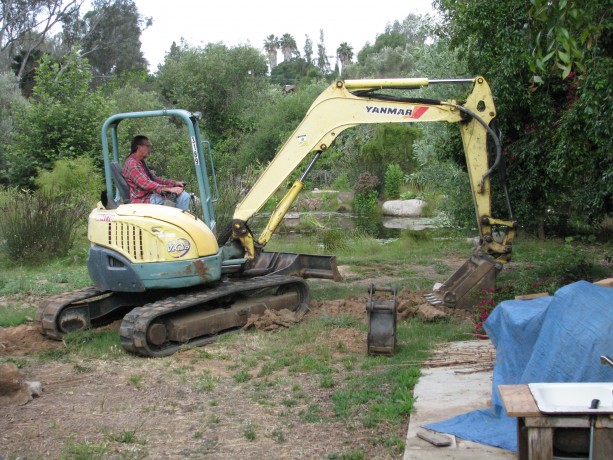
Steve demostrating years of expertise by finessing this large piece of equipment. Last week a new bog area was added to the main pond. The first bog area was dug by hand, created so that there would be a shallow, flat habitat for wading birds and tadpoles.
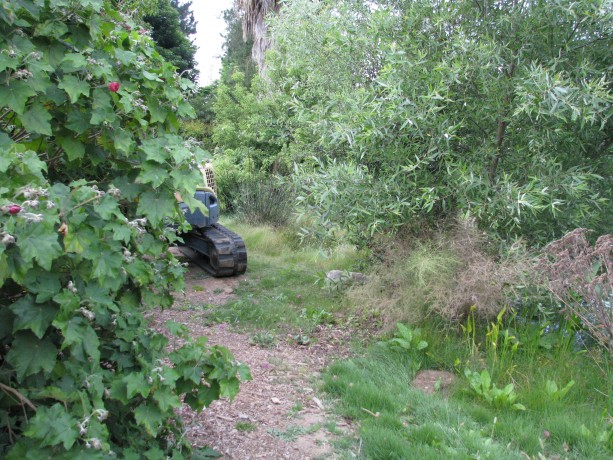
Preparing to start. This is called adding edge, which is an important component of any permaculture design. The first bog is connected to the series of rain catchment basins and now is the link between rain overflow system and the large pond. This year no rainwater left the property; it was all captured. Edge areas in both water and plant design provide more sun and growth areas than a round or straight design. More interesting things happen on the edge.
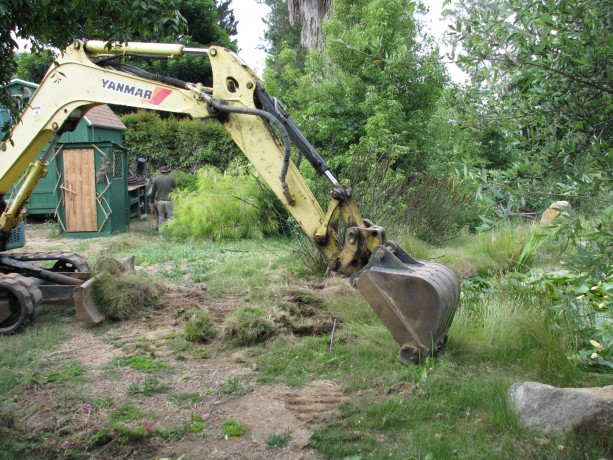
Gentle scraping with the bucket to discover where the subterranean irrigation lines were without stretching them. This bog area was dug up by a tractor bought from a farm auction that I’d shared rental with a friend. It took a large mound of dirt and filled in some dips, leveling a walking and working area.
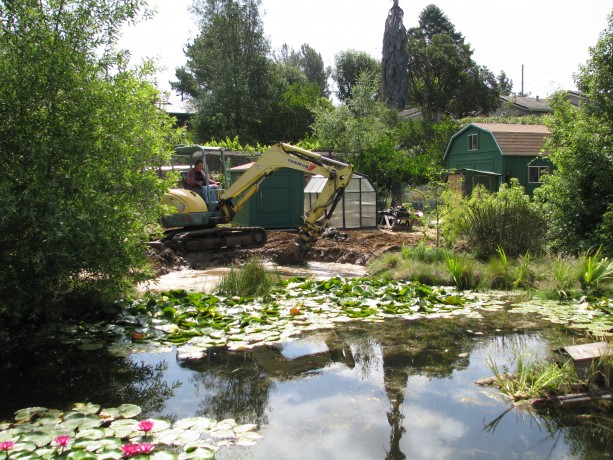
Another, cross-pond view of the new bog. Steve, who among his many talents is also a heavy equipment operator, did a terrific job grading and then expanding the pond. A small problem is that he found some more porous soil with the clay, so the water level on the pond dropped.
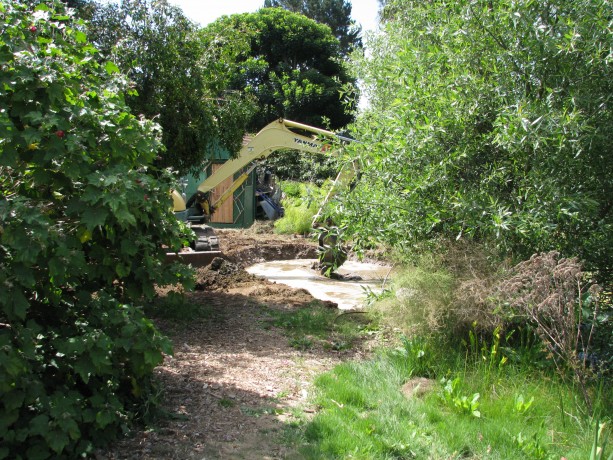
Water is filling in. We’re seeing how far it goes down to tell if the seepage is occurring on the edge or on the bottom of the new area. Once found, we’ll move extra clay over and tamp it all in.
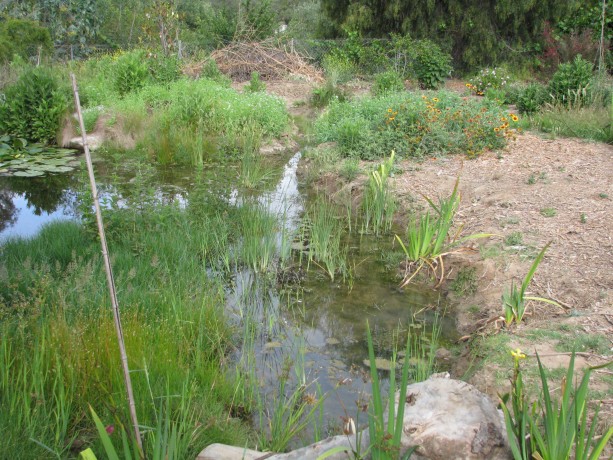
The first, hand-dug bog now filling with plants. Plants Jacob has put into the first bog include graceful cattails, which are a dwarf cattail that isn’t so invasive, iris, rushes, watercress, and some Mexican waterlily.

Sophie admiring the first bog. Very soon the plants will cover the bog areas providing excellent cover for many animal species which… wait for it… live on the edge.
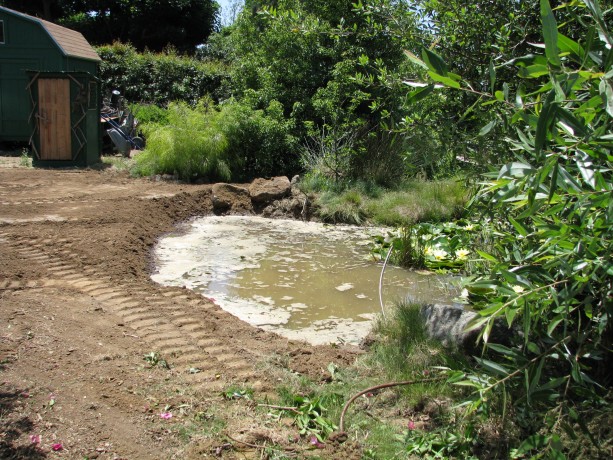
Waiting to see how it sealed and then ready for planting. -
Why Finches Turn Red, and Other Interesting Animal Dating Facts
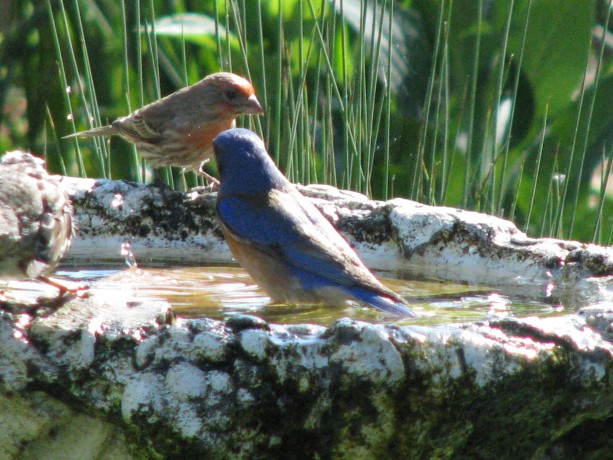
A male house finch and a male western bluebird just as mating season was kicking in. Spring is half-way through and many animals have already had their first batch of young; some are working on their second. Perhaps you noticed when some of the house finches turned a bright shade of red? In fact, many male animals look much differently than the females, becoming more brightly colored, larger, darker, or grow larger horns or antlers. This phenomena is called sexual dimorphism. This is a complicated topic when you begin to analyze all the different forms and shapes boys and girls of the animal kingdom take in order to keep their gene pool going. However I’m going to simplify it because it is pretty darn interesting.
Consider an animal; lets take a house finch. Their lives are spent finding food, finding a mate, finding lots more food for themselves and their young, and surviving predation, accidents and weather. There isn’t much time for playing around. The dawn chorus is the birds calling out that they survived another 24 hours and where is everyone else?
Consider animal calories as money. Finding food and surviving costs a lot of money/calories. For a male house finch to impress a female, they want to make sure they convey the message that they are better at finding food and more macho than the other males. This trait is essentially true for all polygamous (don’t mate for life) animals. (Let that be a lesson learned, girls!) In flocks or packs or herds that are open and often on the move, guys show their wealth through coloration, size and ornamentation. It takes more calories for the finch to turn colors, just like it takes lots of calories for peacocks to be larger and gaudier than females, or cape buffalo to be darker, or ungulates to grow really large horns. But why a brighter shade of red? The bright colors and larger size (in part) show that these males aren’t afraid of attracting the attention of predators because they are strong and macho enough to survive an attack. The darker the color, the more calories, the more fit and healthy, and thus the better food-gatherer and protector for the brood. The guys are saying, “Bring it on!”
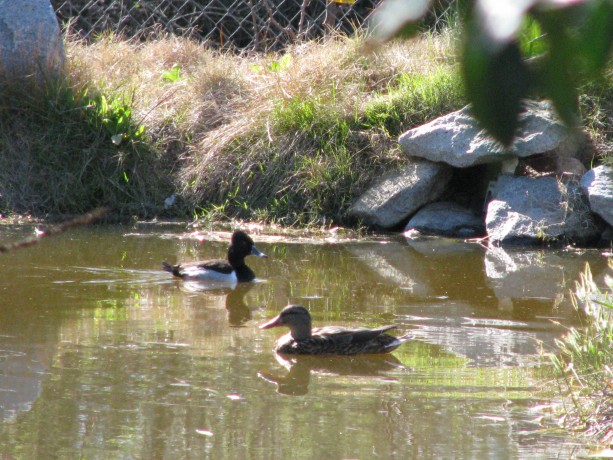
Mallard drakes are very colorful compared to the ducks. Females of these sexual dimorphic species are given a hard rap by being called dull-colored. What they are, of course, are smartly colored. They are camouflage to fit in with the area in which they will be nesting. They are thinking ahead. They don’t go in for dramatic courtship dances because they don’t have to: the guys are desperate for a healthy female to be attracted to them so that they can pass on their genes. It is a buyer’s market. Females also need to store calories because creating eggs or gestating and giving birth then feeding/producing milk and raising kids to maturity is very expensive. Isn’t it, though?
In closed herds or with animals who are monogamous (crows, for instance), the males don’t need to spend money on dates, so dressing up is just considered a waste of money/calories. (Does that sound familiar?).
As I mentioned, there are many variations on the whole sex thing, such as species where the females are larger than the males. Many spiders have this trait and it is supposed that in species who are solitary the females need to be large to be seen by the males, or to have the strength to carry young with them and feed them, and all the males need to spend calories on is, well, you know. Slam, bam, good-bye Ma’am, and all that. Until, of course, he is eaten by the female Black Widow spider. Or is murdered by the female worker bees. So it goes.
When you look out the window and see a brightly colored finch, or a large dark western fence lizard doing push-ups on a warm rock, or see deer with tremendous antlers (deer’s antler are shed every year, by the way. Antelopes have horns which are a one-time shot), you can appreciate how expensive it is for that male to put on such a show to attract a mate.
That pretty much is why we overspend on dates, too.
-
Going Pooless
I’ve been pooless for almost a week. I know, I know, who would have thought that I would do it? I’m sure if my friends knew, they wouldn’t know what to make of it. Even when my daughter called and I told her that I’d been pooless for several days, there was a surprised silence for several moments. In fact, I’ve been around friends, on a consultation job, and out shopping, and no one noticed. I was proud enough of my resolve to reveal my poolessness to a group of teachers who had just completed a 2-hour tour of Finch Frolic Garden last Saturday. After all the cool permaculture things I’d been showing them, their looks of astonishment were no surprise to me.
Why have I gone pooless? Because I’ve heard about how good it is for your skin, your hair and how it combats allergies. It is also inexpensive and easy on the greywater system.
Going without shampoo has been an interesting experiment.
The term ‘going pooless’ was popularized by permies.com lecturer Paul Wheaton. He has a podcast and discussion board about it here if you’d like to hear his and a woman’s year-long account of going soapless, as well as many other comments from people who have been soapless, shampooless and deodorantless for years.
The reason for going pooless is that we shampoo far too much. Shampoo strips away all the natural oils along with the dirt, and then we put more (usually expensive) gook on our hair to make it soft and shiny again. All that gook has lots of harmful chemicals, additives and scents. Commercial shampoos and soaps are dramatically linked to exema and other severe skin problems, allergies, and even migraines. I know several people who have to have ultraviolet treatment on their skin to keep psoriasis in check. One of these people is a clean fanatic, and another dyes her hair and wears a lot of makeup and perfume. I’ve mentioned going pooless or soapless to several people with skin problems, but they’d rather go on doing what they’ve always been doing.
Last week a good friend cut my hair (for barter) and it is short. It had been long enough that I’d been using a little hairspray to keep it out of my face and even when I washed my hair there was a residual product feeling to it. I washed my hair with Dr. Bronner’s castile peppermint soap, and still feeling some product I rinsed with diluted apple cider vinegar. That left my hair soft and clean. I always wash my hair in my morning shower. I continued to do that but instead of using shampoo, just vigorously rinsed it with plain water. This was a challenging time to do this because we entered a heat wave with temperatures rising over 100F, and I gardened, weed-whipped and sweated all through it. I also have the tendency to run my fingers through my hair.
The first couple of days I noticed no difference in my hair after rinsing. Gradually over the weekend my hair began to feel heavier, but it didn’t look greasy (I have oily skin type). I had heard that some people with straight hair who went pooless actually ended up with wavy hair – this was a strong motivator for me, but I’m out of luck. Yesterday I worked in the morning for several hours in the heat outdoors with a hat on, then dragged myself through my shopping chores. I encountered some challenging people and wasn’t in a great mood in the evening. I really like clean hair, too, and my hair was going through the transition stage of adapting to natural oils. It didn’t feel right. So this morning I rinsed it as usual, but also used a very tiny bit of natural shampoo for a quick rinse. I felt guilty about abandoning my project, but when I got out of the shower my hair still felt as if the natural oils were there, but my hair felt lighter. I didn’t strip it, but probably got rid of some extra oil from the extremely hot days. There is an adjustment period with going pooless. After some time your hair adjusts to absorbing the natural oils and then levels out and looks and feels great. Many European women rinse their hair and rub olive oil into it, leaving it in their hair. Their hair is luxurious. Allowing your own body’s oil to do the same thing is even better.
The purpose of soap is just to break the surface tension of water (surfactant) so that water penetrates better. All the rest of the stuff in soap is extra. Some of it can be good, like the addition of oatmeal to soothe skin or pieces of lavender to exfoliate. Many plants – like soapwort – are surfactants. We don’t need to use the harsh chemicals that are in most soaps to do the job. In fact, we really don’t need the soap at all except occasionally. If you don’t want to just rinse your hair with water but would like a more natural solution, dissolve some baking soda in water and use that the way you would soap. Your hair will feel sticky and tangly. Then rinse your hair with diluted apple cider vinegar (or white vinegar). Your hair will be soft, shiny, smooth and lovely because the acid will have neutralized the alkaline baking soda. A vinegar rinse every now and then helps strip product out of your hair anyway.
Going without deodorant or soap are two other venues to investigate, especially if you have any kind of skin issues or recurring headaches. Read some of the testimonials on the permies.com podcast page, or elsewhere on the Internet. Or use more natural ingredients to see what works for you.
I will continue to go pooless, with an occasional light sudsing from a natural shampoo when I feel the need, but I’ll be careful not to strip out the natural oil. If anyone compliments me on my hair, I will be proud to advertise my poolessness!
-
Chick’s New Home
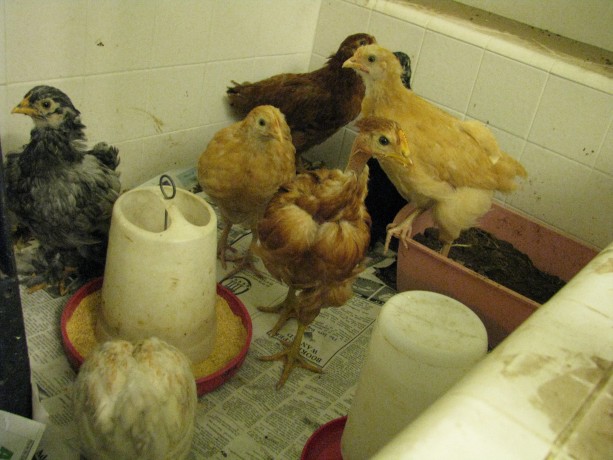
“We’re going where?” I know, I know, another chicken post. This should be the last one for awhile and I’ll get back to plants and chocolate desserts. Today I moved the 6-week-old chicks from out of the bathtub to their new quarters. They are living in a coop within the Fowl Fortress.
The coop had been occupied by Saki, a coturnix quail that ended up being male and thus having to be separate from the other two who were female. Males are extremely aggressive and usually have a harem of at least six. I don’t eat fertile eggs, nor want to hatch more quail so he was separate. He also managed to injure his wing a month ago, then a week ago escape the Fowl Fortress and unfortunately get himself killed. I miss his warbling, frantic call for his ladies. The coop had also apparently been occupied by mice and rats, as I found out when I cleaned out the top nesting portion. The rodents would only use it during the night and disappear like fairies by day, leaving lots of un-fairy-like poo all over the place. I cleaned it out on top while the big girls helped kick out all the old nesting material from the inside.

Getting a little help from my friends (Madge) cleaning out the coop. The girls (and I certainly hope they are!) were so much larger than the last time I carried them outside to the porch that I could only fit three into the banker’s box and had to put another one upside down on top to keep them there for transportation down the hill. I thought I’d put them into the top portion so they’d get familiar with it, then make their way down the ramp to the bottom.
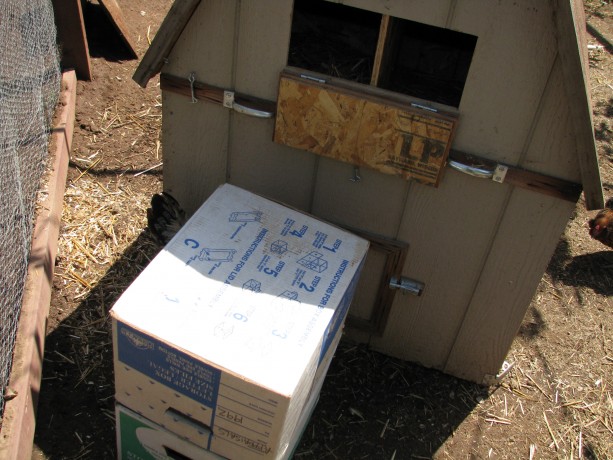
Two banker’s boxes with three huge chicks waiting to be shoved through that egg-collecting door. For over an hour all I heard was rustling, tiny little rushed footsteps and an occasional mini-squawk. I tried to entice them down, but for a long time there were no takers. Finally two came down, and one went up again, then another came down and went up again. About an hour later I looked in and they were all down enjoying the afternoon sun and wondering where the plumbing was (they lived in a bathtub… get it??? 🙂 ).

Little peepers peeping. That’s Esther, and she didn’t come down till last. However after sundown when all the big girls went into their coop, the little girls crowded around in the corner looking bewildered. I had to crawl in there, catch them and shove them back up the escape hole into the roosting area.
Kids. Sigh.
Now I need get the offer of cleaning services and clean the bathroom and the entire mostly empty bedroom which is coated with a thin film of chick dust.
But not tonight.
-
Viola the House Chicken
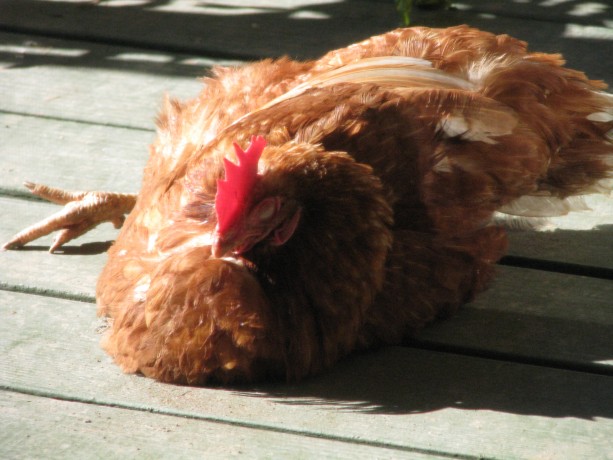
Viola snoozing in the sun. When I tell people that I have a house chicken they look at me funny. Then I launch into the explanation and sometimes afterwards they say, “I want a house chicken!” Or sometimes they just smile gently and pretend they recognize someone else with whom they’d like to speak.
Right now I not only have a house chicken, but I have a bathtub full of chickens. These are the chicks at the six-week stage, and are just about ready to put out in the Fowl Fortress. They are exercising their wings, especially Esther one of the buff orpingtons, which comes to kamikazi-ish flights into the other chicks and scattering them like bowling pins. I can be excused bathtub chickens because, after all, they are temporary. And so, I thought, was my house chicken.

Chicks at six weeks. The only one not looking at the camera is Belle, who has a crossbill and who is eating. The way Viola became a house chicken though will make much sense to you and warm the cockles of your heart.
Viola and Madge were two one-year-old Rhode Island Reds who were raised en masse at a feed store. Although the hens had had their beaks trimmed (poor dears) these two had been severely pecked. Madge is blind in one eye and Viola had a gimpy leg (and, I have come to believe, some psychological damage from the bullying). These two hens have been the sweetest girls, unlike the other hens who were coddled from day #2 and act like complete spoiled brats.
One day last Fall I went to put the chickens away and noticed that Viola was holding one leg up high and not able to put any pressure onto it. Uh-oh, I thought. I felt it all over but couldn’t tell if anything was broken. I set up a cage by the kitchen table with a heat lamp and heating pad, and hoped for the best. I spoke with the vet and researched online and everyone (all poultry-eaters, I’m sure!) said that she’d have to be put down. The leg was probably broken. She was probably in pain and showing a brave face… or beak. Well, I considered having her put down, but she didn’t appear to me to be in tremendous pain. She acted as if she’d pulled a muscle. She ate well, and after a night on the heating pad laid a very nice egg. So I kept her in. After a few days she began to use the leg a little. She certainly ate well. I took her outside into the front fenced area, formerly home to Homer the Desert Tortoise who had escaped the year before. This area has a small pond and all the bird feeders where we watch and count birds for Cornell’s Project Feederwatch. Pretty much a chicken heaven, except for the loneliness. Having been hen-pecked, she didn’t seem to mind so much.
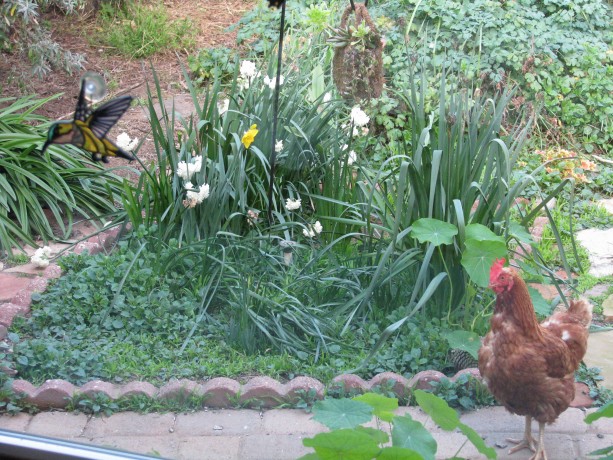
She sees us watching her as she roams Chicken Heaven. Viola improved and we developed a routine. In the morning I’d let her out and sprinkle some food for her outside. She’d wander and sun herself and roll in the dirt and eat bird seed, and lay an egg in Homer’s old house.
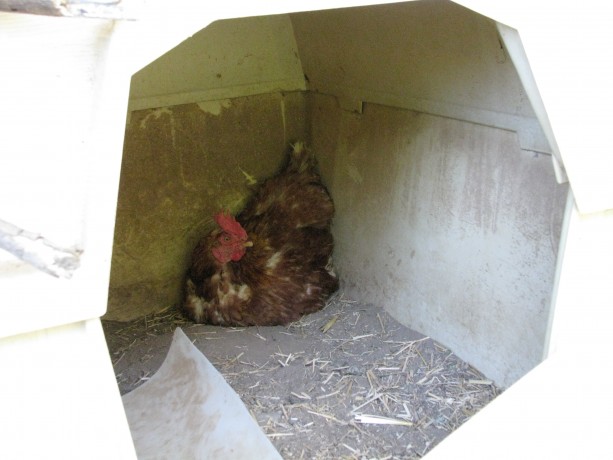
“This doghouse smells like a tortoise.” At dusk she either would tap incessantly at the sliding door to come in, or I’d go out and call, “Vi – o- laaaa,” and she’d run around the corner of the house, up the stairs and inside, making a brief stop to check out Sophie-the-dog’s dinner, then she very nicely cage herself. I’d cover her with a blanket so she could sleep while the light was on. The cats ignored her and Sophie “peace and love in her old age” -the-dog was actually a little intimidated by her. Perhaps she thought Viola was the ghost of chickens past.
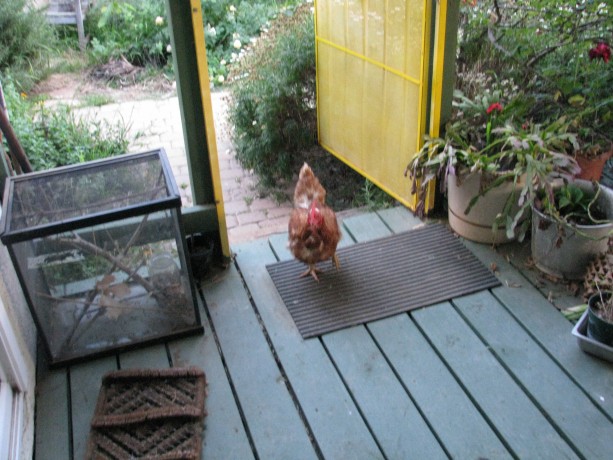
The only animal I have who comes when she’s called. Did I say run? Yes, her leg improved greatly, from a painful hop to a piratey roll. Then I made the mistake of speaking on the phone about her within her hearing. I gave a progress report on how well she was doing, and said that I’d try to reintroduce her to the flock again the next day or so. By the next day, however, Viola suddenly had a very sore leg again. She hobbled painfully around. I couldn’t reintroduce her because the other girls wouldn’t be very nice to her. So I nursed her again. She improved. During the Christmas holidays once more I spoke about reintroducing her, and by the next day she was limping badly again. Guess what? Viola got to stay inside for Christmas.
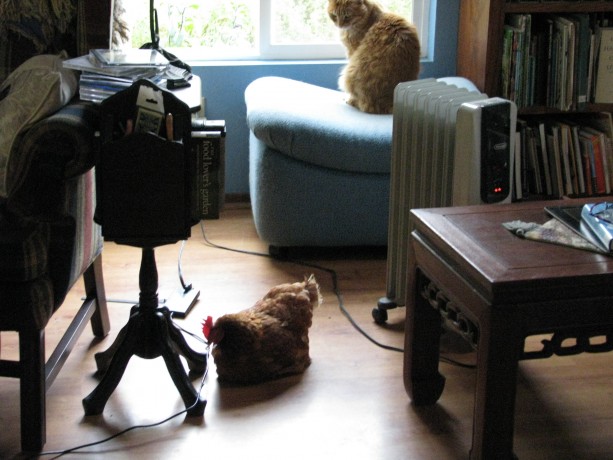
Staying warm by the heater last winter. This healing/reinjury happened yet a third time, and yes I had mentioned bringing her to the coop, so by then I was pretty sure she was either a very good chicken actress, or she was injuring herself to maintain her improved way of life.
The best part of having a chicken in the house I find is at night. While I’m up writing or paying bills and she’s caged, suddenly I’ll hear a sound as if a bomb is falling from a great height just outside the house. It is a high pitched whistle that descends in pitch gradually, but instead of hearing an explosion at the end there is a little soft “brrrup.” The first time I heard it the sliding doors were open and I thought that Camp Pendleton (whose artillery practice shakes the house) had dropped a missle overhead.
When I sneeze or make a loud noise I always hear a comment from the cage. She’ll often croon to herself, too. Viola enjoys music and will sit contentedly both when I’m playing CDs or even when I’m practicing my beginning piano chords on the keyboard. I’m sure she considers herself a songbird because she makes horrible noises of protest when she wants attention.
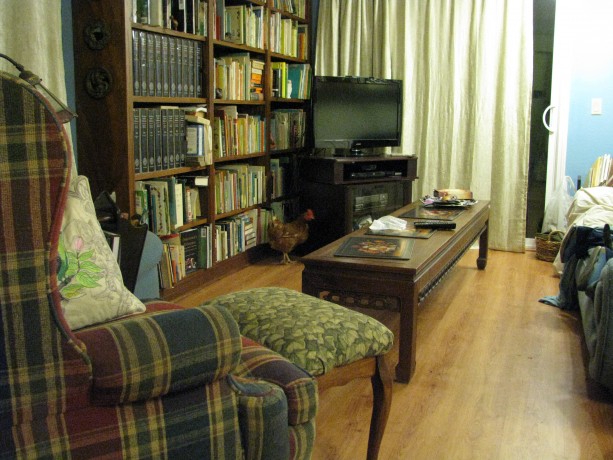
Viola taking a tour of the library. At first I had placed a metal food dish and a flat water dish into her cage. She soon learned that if she stepped on the edge of the metal dish it would clank. She became very good at clanking over and over and over again with her big foot when she wanted out. She’d also manage to spill her water so I’d have to let her out to clean. She’d take the opportunity to run into the other room and check out the cat’s food dishes. Now I just put some feed right on her newspaper, and my daughter cleverly tied open the side door just enough so that Viola can get her head out to drink from a water dish placed outside the cage.

A caged Viola with the waterdish doorway. A friend who knows birds suggested that Viola had bumblefoot, a painful swelling of the pad of her foot. She kindly gave me a week’s worth of antibiotic for Viola in pill form, and I learned a new skill. Or not. By the end of the week Viola and I had developed a whole new relationship which had us eyeing each other warily. There was no change in her condition other than she wouldn’t let me anywhere near her beak without a tussle. Yet again she’s walking very well.
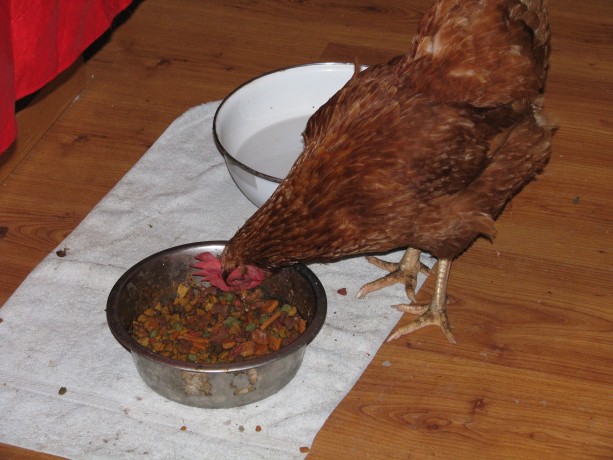
Dog food is high in protein, and fun to steal. I’m not the only one with a house chicken. Social media is a wonderful method of exposing slightly affected people. There are photos of perfectly respectable people – grandparents even – Skyping with a chicken on their laps. There are even businesses who sell products for chickens such as chicken diapers. Yep. Chickendiaper.com, in fact. I didn’t enjoy the diapering part of raising my children so much that I want to reenact it with a chicken, thank you.
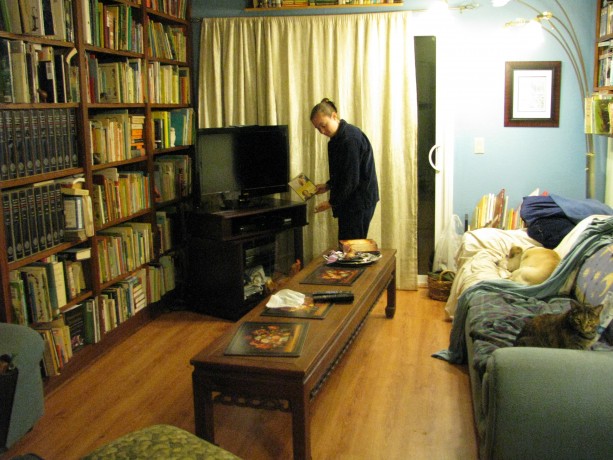
Viola giving her opinion on what video to watch. So here it is the middle of Spring, and Viola’s leg is doing wonderfully. She barely limps. Perhaps I can reintroduce her to the flock at the same time I introduce the chicks. I’m writing this while Viola is rustling about in her covered cage, facing the back of my laptop and unable to read what I’m writing. I just wonder if tomorrow she’ll be limping badly again.
-
Arthritis and Turmeric… What Helped For Me
I’ve had osteoarthritis in my hands for almost fifteen years. I blame all that weed-whipping, pick-axing clay soil, and carrying all the plastic grocery bags in all at once because, by God, I’m not going to make two trips! It has migrated to my back, feet, ankles, and by the way I’m feeling these days my hip. I’m 51 years old. I’m also going through those lovely years of change that women get to experience, which makes my memory more dicey than I’m comfortable with, and some of that is due to my bad back (which I’ve had since a fall on a tennis court when I was 10 snaked my back) and the way I hold all my tension in my shoulders and neck. I’m sure that the tension and slowing of blood circulation that happens between trips to the chiropractor makes me a little ditzier than usual, too.
I’ve been taking glucosamine and chondroiten since my hands first gave me trouble. It worked wonderfully for years, and I’m sure it still does. When I moved to this house – I did all the packing and moving for me and my children – I found that my hands hurt so badly from carrying boxes that I didn’t know how I was going to use unpack or go back to work after my week’s vacation was up. By taking glucosa mine and chondroiten my hands felt better within a couple of days and I was able to continue.
Move through time with me to 2011 when my permaculture garden was installed. I had to drag multiple lengths of water-filled hoses around, haul heavy pots of plants and trees, dig through heavy soil and pull weeds. After it was installed, the next year, I had to dig out the huge rootballs of invasive bamboo that had been planted and replant trees, all of which had been planted deeply in clay inside gopher cages. Oh, and pull weeds. Lots of weeds. Glucosamine and chondroiten weren’t helping with the inflammation, just the lubrication of the joints. My hands hurt so badly that I was in crisis mode, wondering how I was ever going to keep the garden going when I couldn’t even use my hands for a day after pulling weeds. I’d wake up and my hands would be locked partially closed. I’d have to force them open, the fingers clicking as they ratcheted up, and then work them until the joints lubricated. My back hurt a lot. My mind was often in a fog and taking ginko biloba helped only a little. I became very depressed, wondering how life was going to be for me when at fifty I was in that bad a shape, and longevity (but not mental clarity!) was on my mother’s side.
I’d been taking a healing yoga class, and added that when I could two fitness classes a week at the marvelous Wade Into Fitness classes at the local community center. The gentle yoga practice kept me limber and steady, and helped me keep working, yet the artritis pain was still there.
As usual, I already knew the answer but didn’t realize it. I learned from MindZymes.com that the curcumin in turmeric, a spice used in curries, was an anti-inflammatory, so I’d been sprinkling it on my food. Using a lot tastes very bitter and the spice doesn’t go with everything. I’d read that black pepper helps to increase the absorption so I paired them together. No breakfast egg went eaten without being turned yellow and black. Then one day I researched turmeric thoroughly. Turmeric is prescribed by doctors in India like a drug, yet it is completely natural. The warnings for using it include that it may thin blood, may interfere with gall bladder (I had mine out a few years ago), and it hasn’t been tested (in the US) enough to be sure that it is safe for pregnant and lactating women. I read that all illness involves inflammation. Taking an anti-inflammatory can help with all illnesses. Wow. Sprinkling turmeric on my food was fine, but it wasn’t a large enough dosage to help with the inflammation I already had; I’d have to take capsules.
I was skeptical but I was ready to try anything rather than get shots from the doctor, or give up my activities. I’d just invested in this wonderful garden and I could hardly work in it. I bought turmeric capsules at a local herb store. It included phosphatidylcholine, which is a vital component of the human cell membrane and has been proven to play a vital role in our health, including maintaining cell structure, fat metabolism, memory, nerve signalling and liver health. the curcumin in turmeric is difficult for the body to absorb on its own, so the phosphatidylcholine helps increase the absorption by 70%. No, I didn’t know any of this before, I looked it up.
Last September I included the capsules with my daily vitamins and didn’t really think about them anymore. Within a few weeks I realized that when I awoke my hands weren’t stiff and stuck into position anymore. In fact, they didn’t even ache much after a day of weeding. The arthritis would cause shots of pain radiating from a knuckle down a finger like a lightening bolt, coming on without warning and making me gasp, something not fun when out in public. I realized I hadn’t had any of those surprise episodes for awhile. I also realized that when I went to my memory banks to search for a name, often I’d come up with it right away. My memory has never been perfect, but it was functioning better than it had and I felt less stupid and old. The reason for these miracles had to be the turmeric, because nothing else in my diet had changed. I continued taking it, and tested myself. I’d pull weeds, carry groceries and wake up the next morning with only the usual middle-aged aches and pains.
It has been nine months that I’ve been taking turmeric with phosphatidylcholine and every morning I wake up wondering if the spell has been broken. But it hasn’t. I even weed whip for hours and although I’m sore the next day, my hands aren’t locked and they are fully usable. Turmeric isn’t a miracle herb as such; there is no such thing. I still take a minute to loosen up my ankles and back when I get up in the morning, and heaven knows my memory makes conversations with other middle-aged people an exchange of “Um… you know… that thing…”; often more like charades than a dialogue. I still have to be careful and pace myself because the arthritis is still there. However I’m functioning far better than I was a year ago. My hands work!
I’ve recommended turmeric to lots of people, and I’ve had a couple of them tell me that they’ve found improvement since taking it. As I said, I was skeptical when I started and the relief I’ve had is frankly wondrous to me. It is not a cure-all, but as an anti-inflammatory it really worked for me.
I do not have anything to do with the company whose brand I buy; I simply bought what was available locally and it worked so I haven’t tried others. I’ve since begun buying it on the Internet because the local store stopped carrying that brand due to a contract dispute or something (of course!), and I get it for much less cost that way. Again, I receive nothing for recommending the brand, but what I’ve been taking is Source Naturals Meriva Turmeric Complex. Meriva is their trademark name for the phosphatidylcholine. I buy it from AmazonSmile.com (where you can designate a charity to receive a very small donation with every purchase), and found a deal for two bottles for a great price.
Anyway, since this really worked for me, I’m passing on my experiences in hope that maybe it can help you, too. Be sure to research turmeric for yourself to make sure that it doesn’t have any interference with problems you may have, and see what the health practitioners in India have to say about it.
And may all your weeds jump out of the ground at your feet!
UPDATE: It is March, 2017, and I’m still taking this turmeric with excellent results. If I over use my hands I’ll take two capsules in the morning. I switched to another brand that didn’t have the gel caps (I’m vegetarian), and it had a different mixture of turmeric, and within a week I was getting shooting pains in my fingers. I quickly switched back to this brand and the pains stopped. I don’t get anything from this company, I just know that this brand works for me. I use a gas weedwhip for hours, pull weeds, and recently bought a battery pole chainsaw which really taxed my hands and arms, and I’m not suffering from it, all due to the turmeric.
- Animals, Chickens, Permaculture and Edible Forest Gardening Adventures, Pets, Quail, Seeds, Vegetables
Updates on Crate Potatoes, Nursery Plants and Chicks
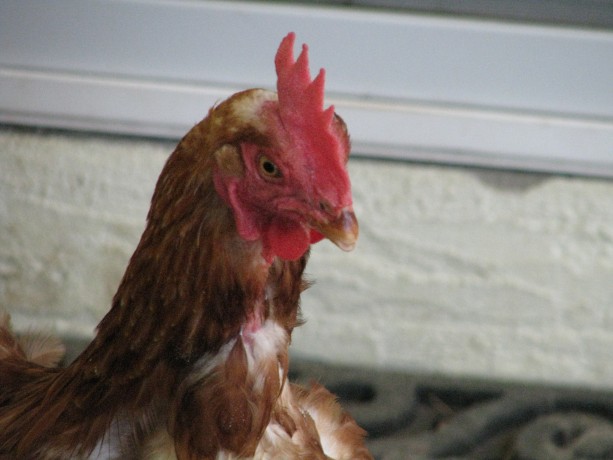
“Whaaa…???” Spring has brought its fervor of growth, of veggies, babies and weeds. Between my bouts of sneezing from pollen (great thing for a gardener to have!), and while the day is very warm outside, I thought I’d update you on how things are going.
A couple of weeks ago I posted about growing potatoes in milk crates. Success so far. The potatoes are growing quickly and coming through the second layer of crates.
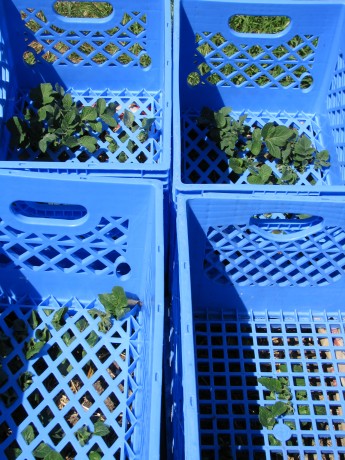
Potato greens emerging through the second layer of crates. I need to backfill with more compost. The potatoes planted in the raised beds have been hilled up as much as the sides will allow. If I am ambitious, I may find some long pieces of cardboard to raise the sides higher, and fill some more.
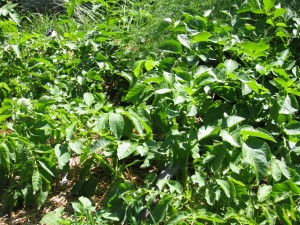
More potatoes! Potato greed!
My nursery bed is mostly ready for transplant out into the larger garden.
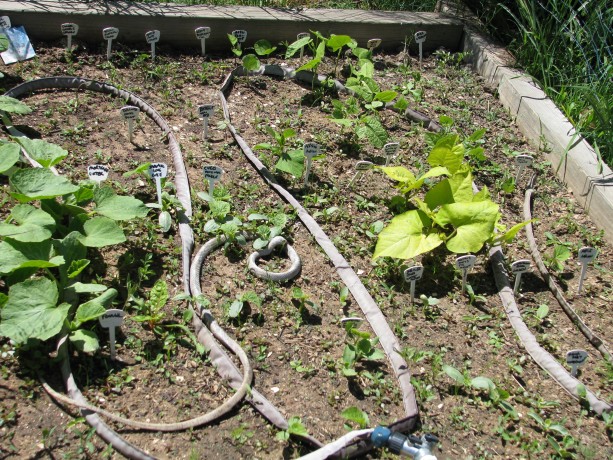
Yes, the rubber snake keeps the birds away. I need more berry baskets to help keep them safe, and I need to build support systems right away for tomatoes and other crops I want to keep off the ground.
The chicks are about a month old. They’ve been living in the downstairs bathtub with heat lamps. There are only seven chicks now. We purchased the eleven on a Wednesday afternoon. By the next evening four were ill. All four died during the night, even after my daughter and I kept them warm and full of antibiotic/vitamin water. We don’t know what happened to them, but at least it wasn’t something that took the whole flock. There are always casualties with day-old chicks. They are shipped in the mail straight out of the egg, with a variety of temperatures, food and terrors. When purchasing a large amount of chicks straight from the hatchery, you’ll often receive extra chicks to ‘make up’ for those that perish. Our chicks that died were both light Brahmas, Annabelle Lee and Daisy, Ruby, one of the Rhode Island Reds, and Hermionie, one of the Americaunas. The rest are growing just fine, although I noticed today that Belle, the remaining Americauna had come to some injury within the last week.
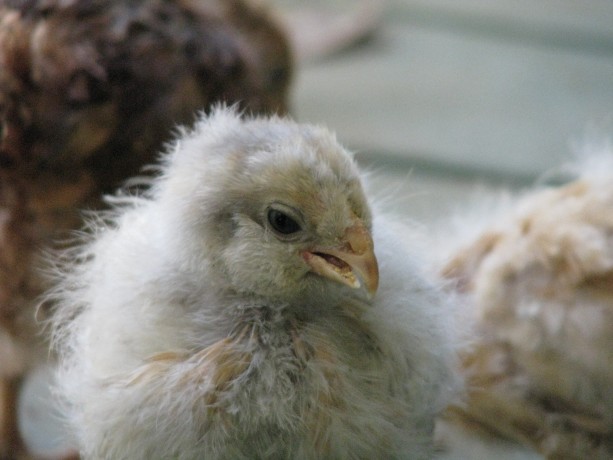
“I’m Belle, the Americauna, and I’m beautiful even with a dislocated jaw.” Her lower beak is crooked and jutted forward, doubtless an injury caused by flinging herself around in the bathtub with the rest of the girls. She is eating well and seems to be aggressive, and there wasn’t anything I could do to the beak with my fingers through massage or gentle manipulation, so I think she’ll have to see it through. UPDATE: my daughter says that she might have ‘crossbill’, which is a genetic condition that gradually shows up. Not much to do about it; some hens thrive and some can’t.
There is always the chance that some of the remaining seven, especially the straight-run cochins, are males, and they will have to find other homes. I’m really hoping for all hens.
Today I not only took the girls out of the bathtub for the first time on a field trip to the warm and safe back porch, but also introduced them to Viola the House Chicken.
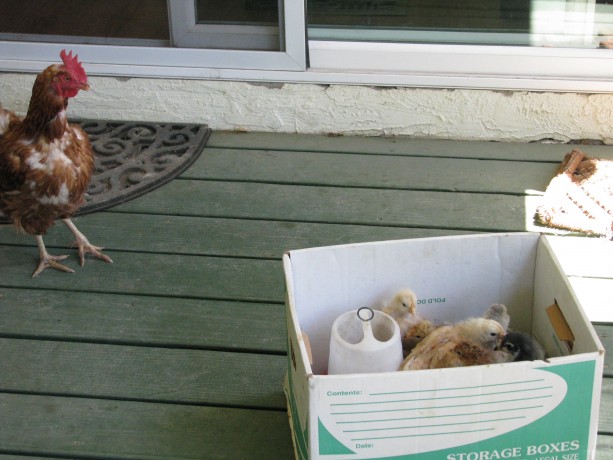
“What the heck are those?” Viola stays in the front yard all day alone, and then comes into the house to her cage at night. She’ll lay in the dog house on the porch where Homer, our lost desert tortoise used to sleep. The chicks are flighty, both in personality and in how they are trying to exercise their wings by sudden wild bursts of flapping that take them off their feet: a surprise to all including themselves. They discovered sunshine, leaf bits, perching,
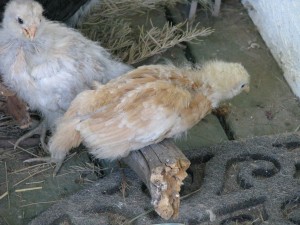
I can perch! and that Viola was absolutely afraid of them. Viola did all she could to get back into the house through the screen while complaining horribly.
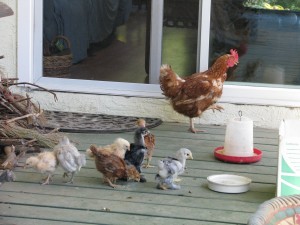
“Get me away! I’m going through the screen if I have to!” I realized that she needed to lay and the chicks were blocking her entrance to the doghouse. I let her in and barricaded the pathway and she settled in whirring grumpily to herself.
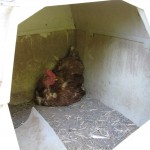
“Can’t you see I’m doing serious stuff here?” Just now I heard her complaining at the top of her lungs to find that the chicks had visited her, and one bold one in particular, aptly named Bodacea, was standing next to her either inquisitively or in horror. I seperated them and they all calmed down.

“I’m Mulan, a black chochin, and I have feet feathers and a cute butt.” 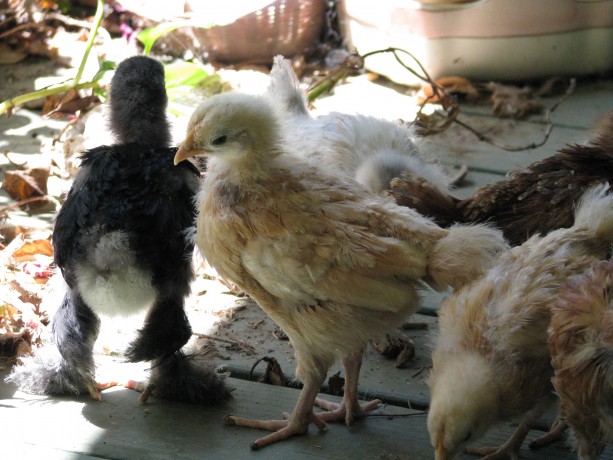
“I’m either Esther or Myrtle, a buff orpington, and she does have a cute butt.” 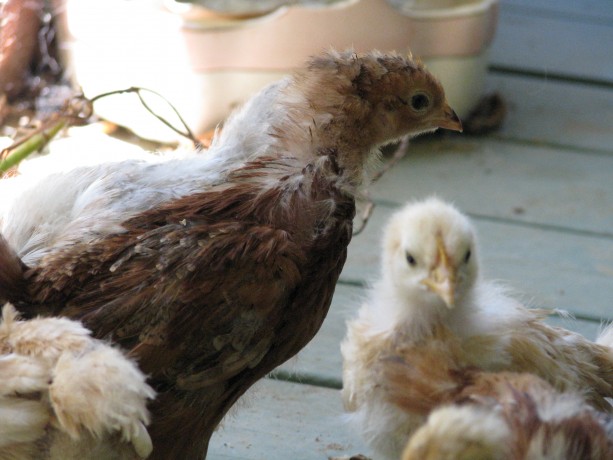
“I’m Charlotte the Rhode Island Red, and I’m going to be just like Viola some day. Without the limp.” 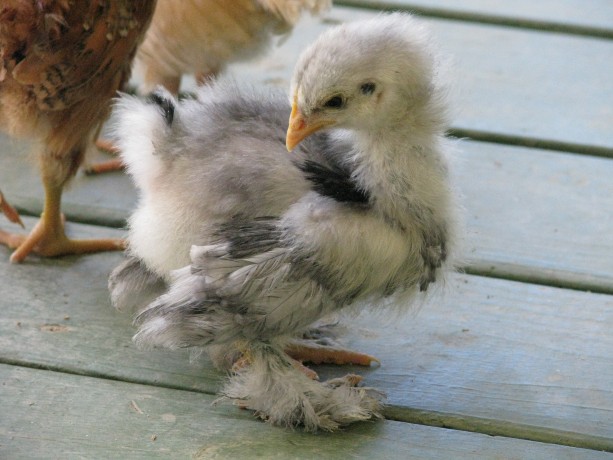
“I’m Bodacea, a blue cochin, and I have a cuter butt.” 
“I’m Malaika, and a Turken isn’t a cross between a turkey and a chicken! We were bred in Transylvania. Go figure.” 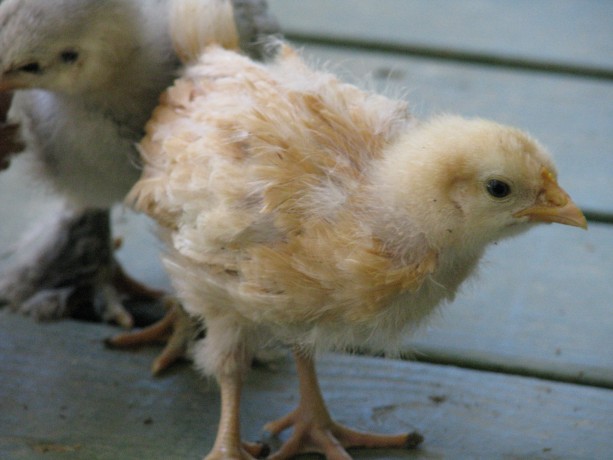
“I’m either Esther or Myrtle, the other buff orpington. The cuter one, obviously.” The nights are still cool and I still have a rat problem in the Fowl Fortress (I’ve been installing a couple of my cats in there overnight to help discourage the looting) so I’m waiting until maybe next week to introduce the girls to the rest of the flock. I’ll oust the Saki the male quail and let the girls take over his house. Its all so complicated!
- Animals, Bees, Chickens, Gardening adventures, Other Insects, Permaculture and Edible Forest Gardening Adventures, Quail, Seeds, Soil, Vegetables
Protecting the Little Guys… and a little about diatomaceous earth
When transplanting little plants out into the big garden it feels like sending your child off to their first day at Kindergarten. All kinds of things can happen to them in the big world. For children… that’s too large a topic for me (Kindergarten mother survivor here). For plants I can give you some advice.
Besides watering too much or too little, and root disturbance while transplanting, little guys can be eaten by bugs, birds or other animals, or simply get lost and overlooked. (Here is a container growing tip: as your seedlings sprout and grow, gently pass your hand across them every time you are with them. It will make for stronger stems.) (And its fun!)(And you can pretend you’re ruffling their hair and say things like, “Hi, Sonny.” Or not.)
A day before transplanting out of a container or from a nursery bed, water the sprouts well. If they’ve been in containers for awhile those roots may be going in circles and the water can’t penetrate from the top very well. If that is the case, put the pots in water for half an hour until moisture is wicked into the pot thoroughly, then allow to drain. I say to do this the day before because if you water just before planting the soil around your root ball will fall apart, breaking fine hair roots and shocking your poor little guy. Some plants hate their roots being touched so much that this would kill them. By the next day after watering the container will still be moist, but the soil should be solid enough to stick together when tipped out.
Dig a hole twice as wide and twice as deep as your plant, then backfill with a mixture of good compost and the soil from the hole. This will help acclimate the roots to the soil change. Water the hole, and if you’re really industrious water with compost tea. Set your plant into the hole and firmly press the soil around the plant. If you are planting tomatoes, eggplant or peppers (all in the same family) you can set the plant more deeply into the hole; they will form more roots from the stems and become sturdier. The rule of thumb otherwise is to plant so that the soil level of the hole is the same as that of the transplant; many plants will rot if soil is up against their stem. If it is too low, the roots will be exposed and dry out. Potatoes can be trenches and hilled up as they grow, or maybe you will try trashcan or crate potatoes. If you live in an arid area, plant in shallows so that rain can accumulate around the plant. If you live in a wet area, plant on hills so water can drain off. Or if you’re practicing permaculture, plant on the swales!
So your little guy is in the ground and gently tamped in. To keep off the birds and bunnies and mice and rats and whatever else is looking for dinner, I use plastic berry cartons turned over and set in place with sticks or with rocks on top. Reuse and repurpose! They are also good for protecting figs . The cartons allow enough sun in, and also makes it very obvious where the seedling is so that you don’t step on it, or weed the little tomatoes out with the almost identical ragweed sprouts. For larger plants, turn over a milk crate.
I have no native quail in my yard. Due to nearby houseing developments, there aren’t many quail around me anymore. Quail would fill the niche of beetle and sowbug eaters. My hens want only worms, spoiled things, and their big feet do a lot of damage if not watched.
Sowbugs cluster under mulch and do damage to stems and fruit.
I use a little food-grade diatomaceous earth around the seedlings, new sprouts in the garden, around the strawberry plants, and also around plants such as artichoke, corn and chard where ants have begun to farm aphids.
I use it around the trunks of my stonefruit trees to stop the ants, and have been told that it works well around the legs of beehives in lieu of or in combination with cups of oil to keep out the ants. Diatomaceous earth is the finely ground bodies of ancient sea creatures (diatoms). The powder on a microscopic level is full of sharp edges.
When a sectioned insect such as an ant, flea or sowbug crawls on it, it rasps their tender areas and dessicates them. Not something I really am happy about doing to the bugs. I’m only using it on a very small scale. Remember that any insecticide, even DE, kills many kinds of insects not just the targets. You don’t want to eradicate your insects; most of them are helping your plants and your soil. DE will melt into the soil when watered, but only reapply if you still see the target bugs. The problem might already be taken care of.
Use food-grade DE, not the kind that is sold in pool supply stores. FGDE is used in graineries to keep weevils and other bugs out of grain and beans, so you’ve been eating it for years without knowing it. It doesn’t hurt us, nor is it bad to breathe (some people wear masks that they can get from https://accumed.com/n95-mask-for-sale-respirator-safety-face-mask-z1.html, just in case). It is a great, natural and inexpensive way to fight fleas without paying big money for poisons to put on your pet. I have it all over my cats’ bedding.
They sell DE sprayers, but they become clogged. The easiest and least expensive applicator (which can be repurposed)? A condiment dispenser. You know, the plastic mustard and ketchup squeeze bottles in diners. I bought a set of two for $2. You can practice a little to dispense a finer dust.
So I plant my little guys, give them a drink, squeeze a little DE around them, give them a berry basket hat until they outgrow it, then take it off to use elsewhere. If there is still a threat to your plants from critters (somebody was eating my eggplant leaves last year! I mean, really…ick!), then turn a wire gopher cage over the top or make a wire cage to fit and use sticks or landscape staples to fasten into the ground.. These, too, you can reuse yearly.
- Compost, Gardening adventures, Permaculture and Edible Forest Gardening Adventures, Seeds, Soil, Vegetables
Crate Potatoes
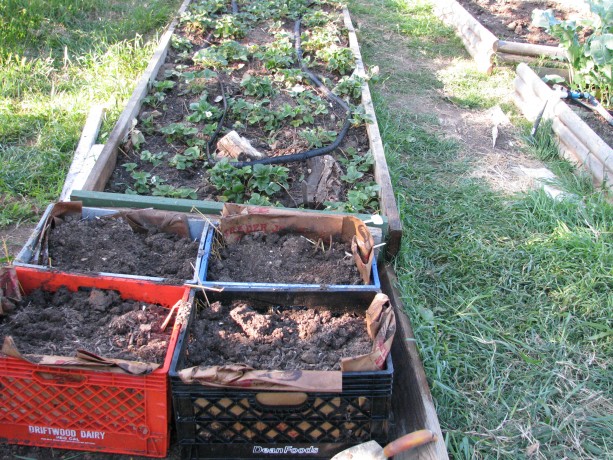
Milkcrate potatoes! This area receives sun for half a day and is shaded on the West side; perfect for keeping them cool. I’ve been frequently asked to write about trashcan potatoes. I haven’t yet, simply because I don’t have a trashcan to use for that purpose. Instead I used what I had and am experimenting with milkcrate potatoes. I’ll let you know how it works.
The potatoes that work in trashcans are any of the standard potatoes in the Solanaceae family, related to tomatoes and eggplants; sweet potatoes and yams are in the morning glory family and grow very differently. A good article with photos that shows growing potatoes in a barrel is at greenupgrader.com. There are many videos on the web about growing trashcan potatoes; a good one is at Farmers Almanac . Two things that she does in this video that I do differently is that after cutting the ‘eyes’ of the seed potatoes, I allow them to harden off for a day or so before planting, and also potatoes can grow with less than 8 hours of light a day which makes it a good over-wintering crop, especially here in Southern California. Potatoes like shorter daylight and cool night temperatures, so plant now! If you plant later, protect the trashcan from the afternoon sun. Hardening off means to allow the cut potato to sit in the shade for a day or so to allow the cut end to form a ‘scab’, or harden up before planting. It helps keep the potato eye from molding and provides protection from insect or bacterial attacks, and keeps drier soil from leaching water out of the potato. This is the same process you’d do when taking cuttings from cactus, geraniums and other easily-rooted, sappy plants. When watering trashcan potatoes, don’t overwater because you’ll rot them. Like their cousin the tomato they’ll do better slightly drier than wetter.
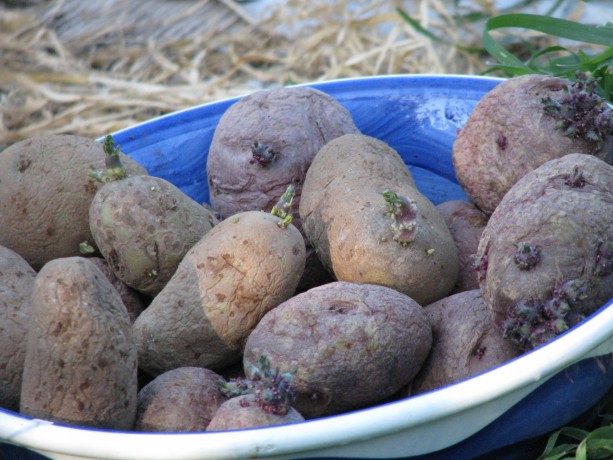
Organic chitted potatoes. ‘Seed’ potatoes aren’t potato seeds. They are small tubers that are ready to plant. Always buy organic seeds. Period. You can buy seed potatoes online or in nurserys available in Southern California just after Christmas, and sometimes in the late Fall. They usually purchase the seed from other states which have snow and don’t ship during the winter. Buying online or from organic catalogs allows you to shop among a wide variety of potatoes differing in size, color and purpose. However since we can plant potatoes in the Fall and don’t want to wait for shipping times, we can buy a bag of organic potatoes locally and sprout them ourselves. Non-organic potatoes have been treated so that they don’t sprout in the store, and are genetically modified (GMO) to last on the shelf. Sprouting potatoes is called ‘chitting’ and is very easy. Mine usually sprout in a bowl on my kitchen counter. Keep them in a light, cool area out of direct sunlight and they’ll grow. When the potatoes have chitted and ‘greened’ (have sprouts), you can either plant them whole or slice them so that each piece has at least one eye. Allow them to harden off and plant them. Give the extras to your neighbor!
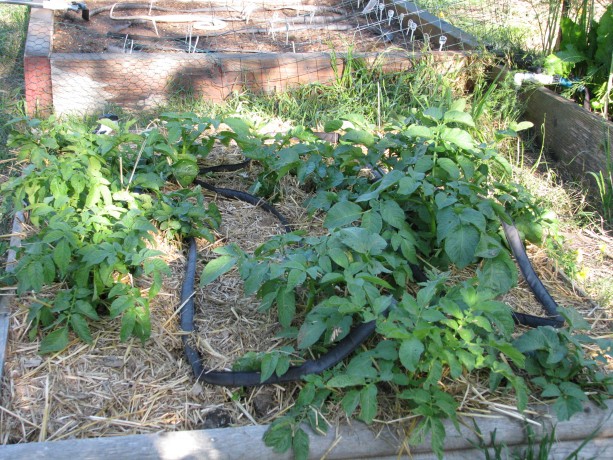
Potatoes can be grown in the ground, or in a raised bed, and then you hill up around the plant to produce more tubers. The reason for growing trashcan potatoes is that you can grow vertically, save garden space, and in particular save your back from trenching, hilling and then digging. The harvest is more productive, too, because you won’t be accidentally cutting through or spearing potatoes in the ground. Potatoes can grow this way because the tubers are actually specialized underground stems called stolons. Potatoes will produce tubers underground, but anywhere along their stems they also can grow a potato under the right conditions. Once you plant a potato ‘eye’, the eyes being the growth buds, it will send out stolons. The plant will produce potatoes below ground, and if you hill up around the stems they will also begin to swell and produce tubers.
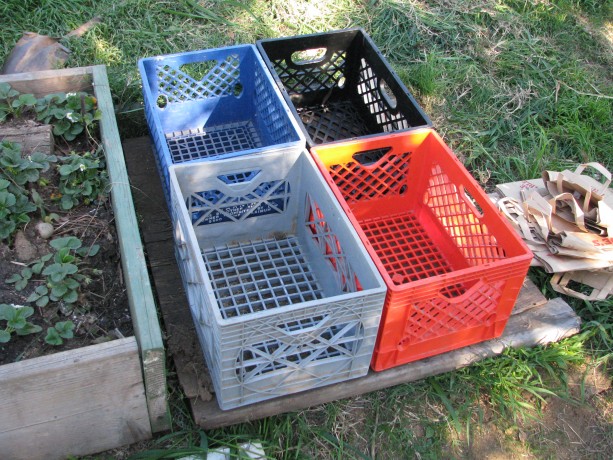
I have extra milk crates, and a source for more, so why not use them? When you plant in a trash can (with drainage holes!), as the greens shoot up you keep layering compost or straw or woodshavings or potting soil or whatever around the stems keeping a little green showing until you can’t fill the trashcan anymore.

I lined the bottoms and the outside edges with extra paper bags and watered them. When the plant is done growing the plant will bloom and sometimes even produce seeds. When the stems die back, you knock over your trashcan and harvest. Save some of the smaller ‘taters for seed for planting in the Fall.
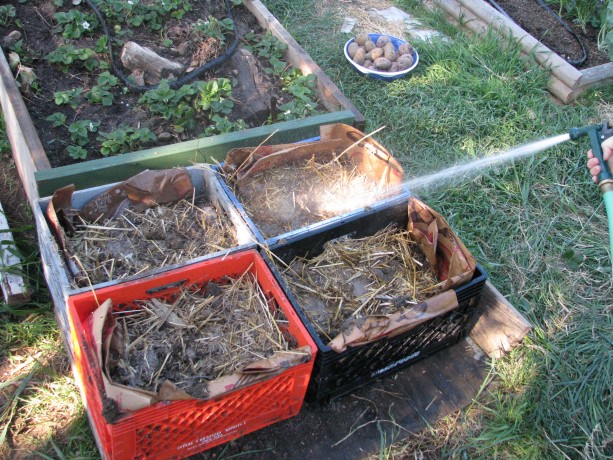
I filled the crates 2/3s full with compost mixed with chicken straw and watered well. You don’t want heavy soil or the potatoes will rot. You also want to insulate the potatoes from outside warmth. You can also root around in there earlier and pick new potatoes, or you can delay your harvest, keep water out of the trashcan and keep it in a cool spot, and harvest when you want them. The beauty of trashcan gardening is that you don’t need a trashcan. Very zen! You can drill holes in a plastic carrier, use burlap sacks, stack old tires, nursery containers, large plant pots or whatever you have. If you have a bottomless or rusted out trashcan, use it! Place it over good garden soil and allow the potatoes to grow down, too. You’ll have a little digging to harvest after you knock over your trashcan full of potatoes, but not much. To make holes in a plastic or aluminum trash can, borrow a digging bar (a long metal pry bar), place your trashcan right-side up on a dirt area, hold the bar high vertically over your trash can pointy side down and let it go. It should make a hole. Or turn the can over and use a hammer and something sharp like an awl or screwdriver (be careful you don’t shatter the top of the screwdriver! You don’t have to pound too hard. Be wise and wear safety glasses just in case). Do this multiple times to make as many holes as you can without making the bottom unstable.
Also be sure to keep the trashcan or crate potatoes in a cool place, especially if you are planting in the early spring here in Southern California. Warmth will keep the potato stems from swelling into tubers. Insulate the potatoes well and keep them cool while still allowing them enough sunlight. Fall and winter are the best times for planting potatoes here, as long as they have adequate drainage.
There is concern about leaching chemicals from plastic, or tires, or aluminum. Do the research and make yourself happy. I don’t think there is that much leaching to be worried about because the plants aren’t in there for a long time. You can always make a barrier between the soil and the sides of the containers with undyed paper or newspapers using soy ink. So save your garden space for other crops, and pop your ‘tatties in a can. Or crate. Or whatever.
Update: here is a very comprehensive article about planting potatoes. Rather than use commercial fertilizer, of course, we recommend rich compost, which will provide what your potatoes need. Also use dead garden debris such as old pea stalks (cut rather than pull them up to allow the nitrogen nodules on the roots to remain in the soil) in your planting bed or container.
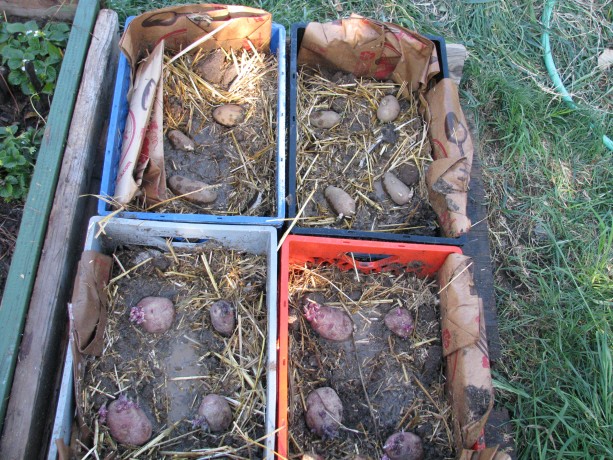
I planted whole potatoes just because I didn’t have room for lots of cut ones and these needed planting or tossing. I then covered them with about an inch of light compost and now I’m waiting!


